
The Pholcidae are a family of araneomorph spiders. The family contains more than 1,800 individual species of pholcids, including those commonly known as cellar spider, daddy long-legs spider, carpenter spider, daddy long-legger, vibrating spider, gyrating spider, long daddy, skull spider, and angel spider. The family, first described by Carl Ludwig Koch in 1850, is divided into 94 genera.

Crevice weaver spiders (Filistatidae) comprise cribellate spiders with features that have been regarded as "primitive" for araneomorph spiders. They are weavers of funnel or tube webs. The family contains 18 genera and more than 120 described species worldwide.
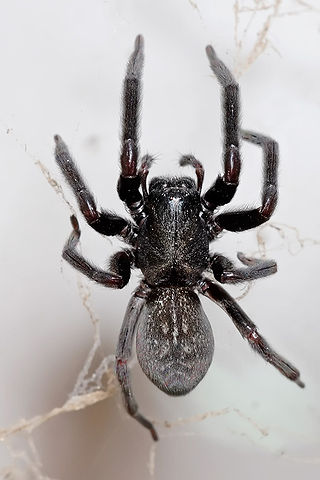
The black house spider or common black spider is a common species of cribellate Australian spider, introduced to New Zealand and Japan. A closely related species, Badumna longinqua, the grey house spider, has a similar distribution, but has also been introduced to the Americas.

Portia labiata is a jumping spider found in Sri Lanka, India, southern China, Burma (Myanmar), Malaysia, Singapore, Java, Sumatra and the Philippines. In this medium-sized jumping spider, the front part is orange-brown and the back part is brownish. The conspicuous main eyes provide vision more acute than a cat's during the day and 10 times more acute than a dragonfly's, and this is essential in P. labiata′s navigation, hunting and mating.

Cribellum literally means "little sieve", and in biology the term generally applies to anatomical structures in the form of tiny perforated plates.

Scytodes thoracica is a spitting spider, so called because it spits a venomous sticky silken substance over its prey. Its size ranges between 3–6 mm (0.12–0.24 in). The carapace is unusual in sloping upwards towards its rear end, whereas the abdomen slopes downwards.

Gradungulidae, also known as large-clawed spiders, is a spider family endemic to Australia and New Zealand. They are medium to large-sized haplogyne spiders with three claws and two pairs of book-lungs similar to Mygalomorphae. Some species build extensive webs with an upper retreat tangle and connecting threads to scaffolding. This supports the ladder-like catching platform that is glued to the ground. Progradungula, a large spider with long legs like Hickmania, and Macrogradungula are the only cribellate genera of the family.
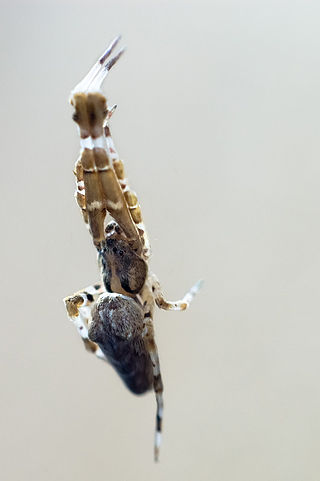
Uloborus walckenaerius, also known as the feather-legged spider, is a cribellate spider in the family Uloboridae. Like all spiders in this family, they do not have venom glands and immobilize their prey with over 140 metres of thread. They are named in honor of Charles Athanase Walckenaer.
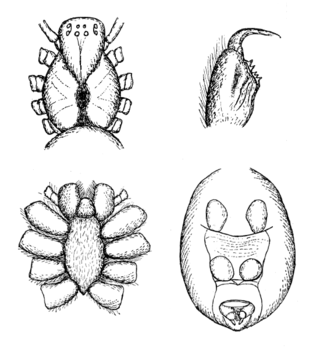
Hickmania is a monotypic genus of Australian cribellate araneomorph spiders in the family Gradungulidae, containing only the Tasmanian cave spider. The genus was first described by Willis J. Gertsch in 1958, and has been found only in Tasmania. It is the last of an old Gondwanan lineage, long since separated from its closest relatives in South America. It is an icon species for faunal conservation in Tasmania, and is named in honor of V. V. Hickman, a professor at the University of Tasmania, who specialized in spiders. The species name is derived from the Ancient Greek τρωγλοδύτης (troglodytes), meaning "cave-dweller".

Progradungula is a genus of Australian large-clawed spiders that was first described by Raymond Robert Forster and Michael R. Gray in 1979. As of May 2024 it contains only three species: P. barringtonensis, P. carraiensis and P. otwayensis.

The anatomy of spiders includes many characteristics shared with other arachnids. These characteristics include bodies divided into two tagmata, eight jointed legs, no wings or antennae, the presence of chelicerae and pedipalps, simple eyes, and an exoskeleton, which is periodically shed.
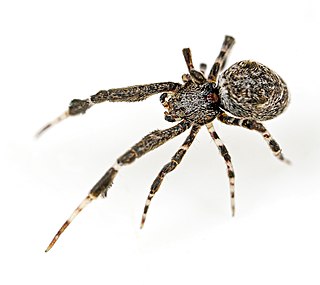
Uloborus plumipes is a species of Old World cribellate spider in the family Uloboridae. Common names include the feather-legged lace weaver and the garden centre spider, the latter name being due to its frequent occurrence of this spider in garden centres. The species name is derived from the Latin pluma "feather" and pes "foot".

Pholcus phalangioides, commonly known as the cosmopolitan cellar spider, long-bodied cellar spider, house ghost spider or one of various types called a daddy long-legs spider, is a spider of the family Pholcidae. This is the only spider species described by the Swiss entomologist Johann Kaspar Füssli, who first recorded it in 1775. Its common name of "daddy long-legs" should not be confused with a different arachnid group with the same common name, the harvestman (Opiliones), or the crane flies of the superfamily Tipuloidea.

Portia schultzi is a species of jumping spider which ranges from South Africa in the south to Kenya in the north, and also is found in West Africa and Madagascar. In this species, which is slightly smaller than some other species of the genus Portia, the bodies of females are 5 to 7 mm long, while those of males are 4 to 6 mm long. The carapaces of both sexes are orange-brown with dark brown mottling, and covered with dark brown and whitish hairs lying over the surface. Males have white tufts on their thoraces and a broad white band above the bases of the legs, and these features are less conspicuous in females. Both sexes have tufts of orange to dark orange above the eyes, which are fringed with pale orange hairs. Males' abdomens are yellow-orange to orange-brown with blackish mottling, and on the upper sides are black and light orange hairs, and nine white tufts. Those of females are pale yellow and have black markings with scattered white and orange-brown hairs on the upper side. P. schultzi has relatively longer legs than other Portia, and a "lolloping" gait.
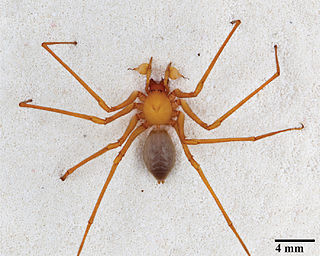
Trogloraptor is a genus of large spiders found in the caves of southwestern Oregon. It is the sole genus in the family Trogloraptoridae, and includes only one species, Trogloraptor marchingtoni. These spiders are predominantly yellow-brown in color with a maximum leg span of 3 in (7.6 cm). They are remarkable for having hook-like claws on the raptorial last segments of their legs.

Progradungula otwayensis, commonly known as the Otway odd-clawed spider, is a species of cribellate spider endemic to the Great Otway National Park of Victoria, Australia. It is one of only three species in the gradungulid genus Progradungula.

Hyptiotes paradoxus, also known as the triangle spider, is a cribellate orbweaver in the family Uloboridae.

Hypochilus thorelli is a species of spider in the family Hypochilidae. Unlike almost all other araneomorph or "true" spiders, members of the family have four book lungs. They are often called "lampshade spiders" because of the shape of their webs which are usually built underneath ledges or projections. H. thorelli is found in the southern Appalachian Mountains of the eastern United States.
Gelotia lanka is a species of jumping spider of the genus Gelotia. It is endemic to Sri Lanka.

Progradungula barringtonensis is a species of cribellate spider endemic to the Barrington Tops National Park of New South Wales, Australia. It is one of only three species in the gradungulid genus Progradungula. At the time of description only an adult male and a number of juveniles were known. Progradungula has been described as a "ghost of Gondwana", surviving though several mass extinctions in relictual populations across Australia.


















